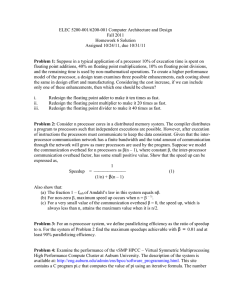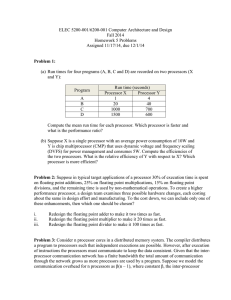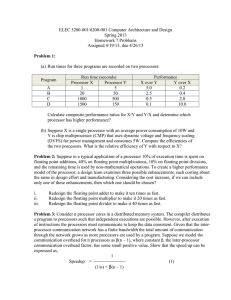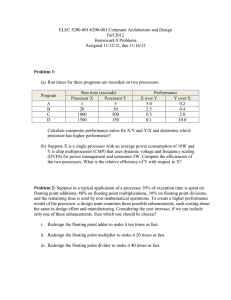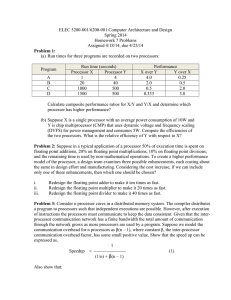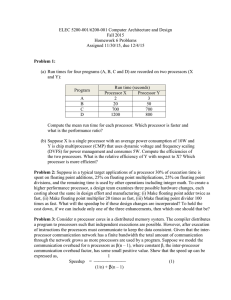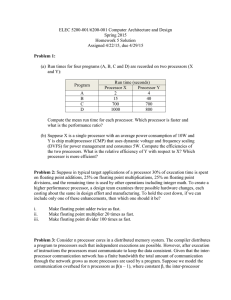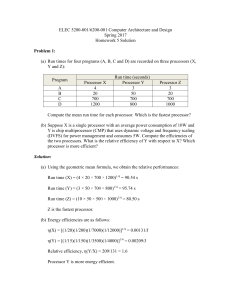ELEC 5200-001/6200-001 Computer Architecture and Design Spring 2012 Homework 9 Problems
advertisement
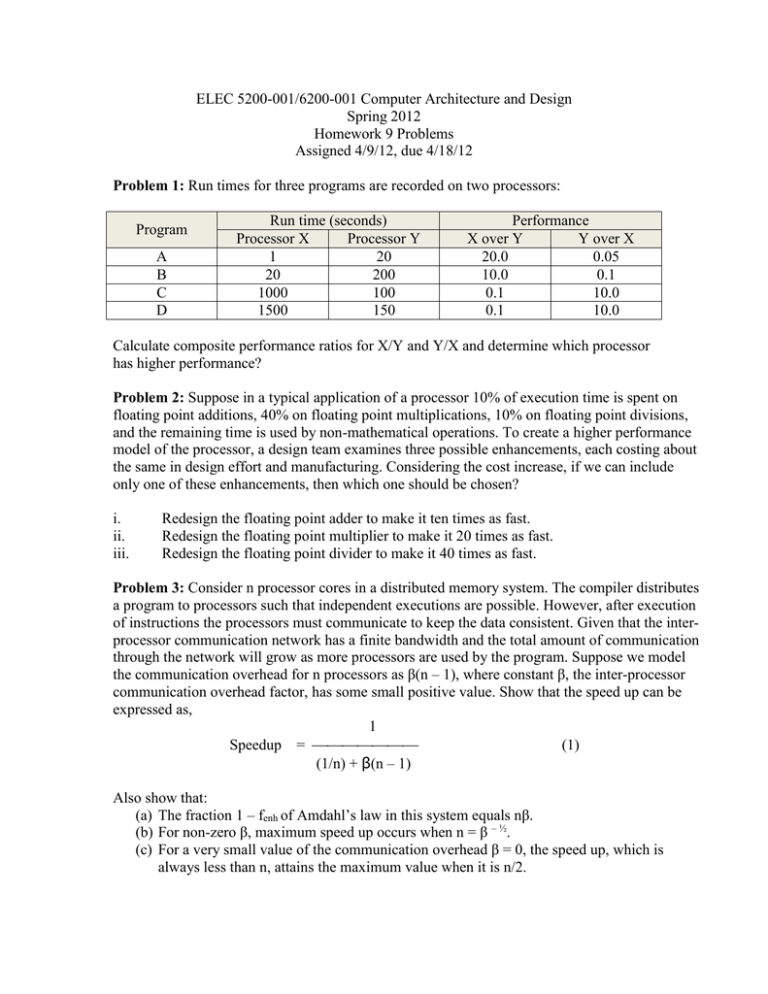
ELEC 5200-001/6200-001 Computer Architecture and Design Spring 2012 Homework 9 Problems Assigned 4/9/12, due 4/18/12 Problem 1: Run times for three programs are recorded on two processors: Program A B C D Run time (seconds) Processor X Processor Y 1 20 20 200 1000 100 1500 150 Performance X over Y Y over X 20.0 0.05 10.0 0.1 0.1 10.0 0.1 10.0 Calculate composite performance ratios for X/Y and Y/X and determine which processor has higher performance? Problem 2: Suppose in a typical application of a processor 10% of execution time is spent on floating point additions, 40% on floating point multiplications, 10% on floating point divisions, and the remaining time is used by non-mathematical operations. To create a higher performance model of the processor, a design team examines three possible enhancements, each costing about the same in design effort and manufacturing. Considering the cost increase, if we can include only one of these enhancements, then which one should be chosen? i. ii. iii. Redesign the floating point adder to make it ten times as fast. Redesign the floating point multiplier to make it 20 times as fast. Redesign the floating point divider to make it 40 times as fast. Problem 3: Consider n processor cores in a distributed memory system. The compiler distributes a program to processors such that independent executions are possible. However, after execution of instructions the processors must communicate to keep the data consistent. Given that the interprocessor communication network has a finite bandwidth and the total amount of communication through the network will grow as more processors are used by the program. Suppose we model the communication overhead for n processors as β(n – 1), where constant β, the inter-processor communication overhead factor, has some small positive value. Show that the speed up can be expressed as, 1 Speedup = (1) (1/n) + β(n – 1) Also show that: (a) The fraction 1 – fenh of Amdahl’s law in this system equals nβ. (b) For non-zero β, maximum speed up occurs when n = β – ½. (c) For a very small value of the communication overhead β = 0, the speed up, which is always less than n, attains the maximum value when it is n/2. Problem 4: For an n-processor system, we define parallelizing efficiency as the ratio of speedup to n. For the system of Problem 3 find the maximum speedups achievable with β = 0.01 and for at least 90% parallelizing efficiency. Solution: As n increases, speedup increases but at a slower rate than n. Thus, while speedup increases with n, parallelizing efficiency drops. From the given definition of parallelizing efficiency and using equation (1) from Problem 3, Parallelizing efficiency = Speedup/n Therefore, 1/n 1 = = ≥ 0.9 (1/n) + β(n – 1) 1 + β(n – 1)n n(n – 1) ≤ 1/(9β) For β = 0.01 we get the following result: n(n – 1) ≤ 11.11, n = 3, speedup = 2.83 Problem 5: Examine the performance of the vSMP HPCC – Virtual Symmetric Multiprocessing High Performance Compute Cluster at Auburn University. The description of the system is available at: http://eng.auburn.edu/admin/ens/hpcc/software_programming.html. This site contains a C program pi.c that computes the value of pi using an iterative formula. The number of iterations in pi.c may be set between n = 140,000 and n = 200,000 so that the run time of a single processor is significant (~5 minutes). Note that this n is different from the number of processors in the previous problems. Here, the number of processors is ppn. Compile and run the program varying the number of processors, ppn = 1, 2, 3, 4, 5, . . . until the performance starts to drop. Plot the run time (normalized with respect to the run time for ppn = 1) as a function of ppn. Use Matlab curve fitting program to fit equation (1) of Problem 2 and find the value of the parameter β.
